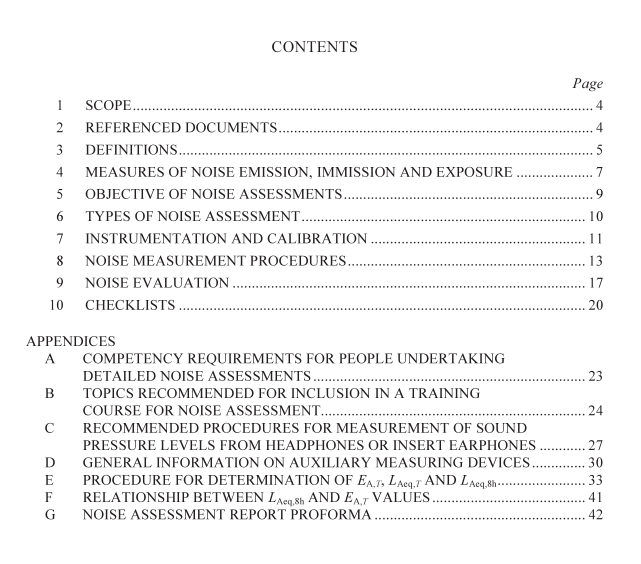AS NZS 1269.1 pdf download – Occupational noise management Part 1: Measurement and assessment of noise immission and exposure

AS NZS 1269.1 pdf download – Occupational noise management Part 1: Measurement and assessment of noise immission and exposure
3.4 Exposure to noise Exposure to noise is determined at the person’s ear position without taking into account any protection that may be afforded by personal hearing protectors.
3.5 Partial noise exposure The exposure of a person to noise over a specified time interval, typically the time spent at a specified workstation, or while performing a specified task.
3.6 Peak sound pressure level In decibels, is 10 times the logarithm to the base 10, of the ratio of the square of the maximum instantaneous sound pressure to the square of the reference sound pressure (20 μPa). (Symbol: L peak ) NOTE: L peak is not the same as the maximum r.m.s. level and is either unweighted or C-weighted according to the appropriate legislation.
3.7 Reference sound source A device which generates a sinusoidal sound pressure of specified level and frequency when used with a particular model of microphone in a specified manner.
3.8 Representative working day A working day during which the noise exposure is representative of the person’s long-term occupational noise exposure.
NOTE: The representative working day should be made up of segments proportioned in accordance with the person’s long-term occupational noise exposure in such a manner that where the exposures differ markedly from day to day, the segments utilized should take such variability into account.
3.9 Sound level or weighted sound pressure level In decibels, is 10 times the logarithm to the base 10 of the ratio of the square of a given sound pressure, obtained with a standardized frequency-weighting and a standardized exponential time-weighting during a stated time period, to the square of the reference pressure. (Symbol: L X,F or L X,S (see Note)).
NOTE: X is one of the standardized frequency weightings A, C or unweighted and F and S are standardized exponential time weightings as defined in AS 1259.1 and AS IEC 61672.1.
3.10 Sound pressure level (Lp) Sound pressure levels, in decibels, is 10 times the logarithm to the base 10 of the square of the ratio of the sound pressure to the reference sound pressure. In air the reference pressure is 20 µPa. The sound pressure level is defined by the following equation:
where
p = the r.m.s. sound pressure in pascals,
p o = The reference sound pressure, 20 µPa
3.11 Total daily noise exposure
Is the total of a person’s partial noise exposures over a working day.
4 MEASURES OF NOISE EMISSION, IMMISSION AND EXPOSURE
4.1 Measures of emission (of a source)
The acoustic energy emitted by a sound source is measured either in absolute terms as emission sound power in units of watts (or milliwatts, microwatts or similar), or in relative terms as emission sound power level in units of decibels relative to a reference quantity of 1 picowatt. Another common emission measure is emission sound pressure level, the sound pressure level measured at a specified location (such as the operator position in the case of a machine) in precisely defined acoustical conditions. In practice, emission sound power level and emission sound pressure level are commonly used to indicate the noise emitted by items of industrial equipment. It is becoming increasingly common for manufacturers to include noise emission details of their products in product specifications.
This is now required by law in several jurisdictions. Standardized noise emission quantities are valuable to purchasers because they enable specific noise limits to be stated in tender specifications. Noise emission information provided by manufacturers and suppliers enables purchasers to assess the potential noisiness of competing items prior to purchase and has fundamental value in making and justifying a final purchasing decision.
4.2 Measures of immission and exposure
4.2.1 General Immission and exposure magnitudes may be expressed directly in units of sound pressure (Pa) and squared sound pressure × time (Pa 2 h) respectively, or indirectly as immission and exposure levels in decibels relative to specified reference values. NOTE: Key terms and units to indicate emission, immission and exposure are given in Table 1.
4.2.2 Immission (at a location) Immission over time interval T is generally measured in terms of equivalent continuous sound pressure level, L Xeq,T . The weighting X and the time of commencement and duration of T depend on the purpose of the measurement. A-weighting is used for most purposes. Peak sound pressure levels are measured unweighted or C-weighted. T typically refers to the duration of a machine operating cycle, task or process, or the length of time a person is present at a particular workstation. NOTE: Where more detailed information is required about the characteristics of the noise, more refined measures of noise immission may be used, e.g. immission sound pressure levels in octave or third-octave-bands.









